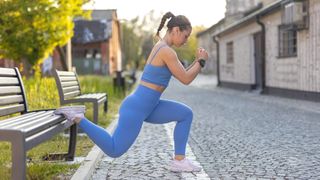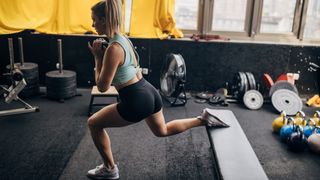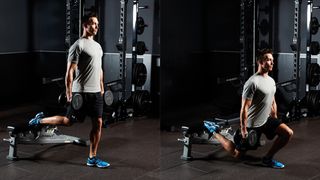How To Do The Bulgarian Split Squat
Whether you’re a rugby player, boxer or runner, this is the single-leg squat variation you need

The squat has been a favourite leg exercise ever since someone first decided to beef up their glutes and quads, and there are innumerable types of different squats you can add to your workout routine.
You can sumo squat, goblet squat, pistol squat, box squat… Basically anything that involves some kind of hunkering down on your haunches is going to strengthen your legs. No squat repertoire, however, is complete, without some kind of split squat. And the toughest kind of split squat is the elevated split squat, commonly known as the Bulgarian split squat.
The only difference from a standard split squat is that the rear foot is elevated but this small change brings a host of benefits, although it increases the difficulty considerably.
To help you successfully add the Bulgarian split squat to your training, we spoke to Fiona Scott, head of physical performance and academic liaison at Performance Herts at the University of Hertfordshire.
Read on to find out how to perform the perfect rep, expert tips for making the most of this movement, how it differs from a standard lunge and some variations to try in your training.
Fiona Scott is a strength and conditioning coach with 15 years’ experience in the sports and fitness industry. She has worked with the England and Arsenal women’s football teams, and Olympic and Paralympic athletes.
Scott is the head of physical performance and academic liaison at Performance Herts at the University of Hertfordshire.
She has a BSc in sport and exercise science from the University of Birmingham and an MSc in strength and conditioning from Middlesex University. Scott is also a certified strength and conditioning coach (CSCS), UK Strength and Conditioning Association accredited coach (ASCC) and corrective exercise specialist (CES).
Bulgarian Split Squat Benefits
The Bulgarian split squat is a unilateral exercise which can help to even out any strength imbalances. “It’s always worth having some single-limb movement in any training programme,” says Scott. “Training out asymmetry is important because we are all slightly one-sided. I’ve worked with athletes from tennis and golf, where the activity is extremely one-sided, but even with a more bilateral exercise like swimming there is still a dominant arm and leg.
“It’s a big compound exercise, so you’re using a lot of muscles at the same time with just one movement. You’re prioritising the quads and glutes primarily, with a little bit of hamstring activation too. Because of the single-leg stance you’re getting a little bit more stability, balance and core activation than a standard squat.”
Get the Coach Newsletter
Sign up for workout ideas, training advice, reviews of the latest gear and more.
All of the above could be said of the split squat, so what do you get from placing your rear foot on an elevated platform like a bench or box? “It allows you to load the front leg more than a normal split squat and increases the quad dominance of the movement,” says Scott. “You’re also increasing the range of motion that you are training, which can be beneficial for mobility.
“A lot of us sit too much in our everyday lives in this day and age, so by having the back foot raised you’re instantly getting a hip flexor stretch on the back leg at the same time as strengthening the quad and glute in your front leg.”
And finally, it’s a convenient way to progress from the basic squat if you don’t have access to any equipment. “It’s a great exercise because you don’t need much equipment to do it,” says Scott. “We used it a lot during COVID when people were in need of effective home workouts. All you need is something that’s around mid-shin to knee height to rest your rear foot on.”
Bulgarian Split Squat Instructions

Getting into the starting position can be challenging. Many people begin by standing, putting their foot back and then hopping around until the distance feels right. This method is superior in our opinion: sit on the bench with your rear foot under your opposite glute, extend your working leg so it is straight and your heel is resting on the floor, and then stand up and move your rear foot across so it is resting on the bench behind you. Scott recommends having your heel directly above your toes for added stability, but you can rest the top of your foot on the bench if you find that more comfortable.
Keeping your hips square, bend your knees to lower until your front thigh is almost horizontal, keeping your knee in line with your foot. Don't let your front knee travel beyond your toes. Drive up through your front heel to return to the starting position.
You can add load in a range of ways – Scott advises starting with a dumbbell in the goblet position – but whichever you choose, your trunk should lean slightly forwards when you bend your knees, and you should maintain a neutral spine.
Bulgarian Split Squat Form Tips

Master the split squat first “I wouldn’t progress to the Bulgarian split squat until you’ve mastered the standard split squat,” says Scott.
Foot placement “The mistake people often make when performing split stance movements is they place their feet too close to being in line,” says Scott. “Keep your feet hip-width apart to help you stay balanced. Imagine you’re standing on parallel train tracks rather than a straight line.”
Front-foot placement “Generally, you need to place your front foot in a position so that, when you bend both knees, your front knee doesn’t come over your front toes,” says Scott. Standing closer to the bench will also put greater emphasis on your quads. Don’t stand too close though or you risk triggering knee pain.
Rear-foot placement “Don’t place your foot too far back on the bench or box, or you’re going to hit your shin before you reach a full range of motion,” says Scott.
Lunge Vs Bulgarian Split Squat
Lunges and Bulgarian split squats have a lot in common. They’re both leg exercises, they’re both quad-dominant, and they’re both unilateral movements, but there’s a difference it’s worth knowing about.
“With a Bulgarian split squat, your feet are in a staggered position and they stay fixed – you just move up and down,” says Scott. “With a lunge, you step into the movement, making it more dynamic.”
And that distinction makes each one better suited to a different purpose. “You can load more with split squats as you are in a fixed position,” Scott says. This makes it a good choice for strength and hypertrophy training because you can overload the muscles.
“If you’re training for a sport where lunges are a key part, like squash, then you need to get better at lunges,” says Scott. “During a more sport-specific period of someone’s training, we would put in relevant exercises like dynamic lunges. You can perform these forwards, backwards, laterally, multi-directionally or while walking. The negative is they reduce the load you can lift. They’re more powerful, explosive movements that rely on you having good form, but there are more shearing forces on your joints so you might find them less favourable if you’ve had knee injuries in the past.”
Bulgarian Split Squat Variations
Gym ball Bulgarian split squat
One of the key challenges of the elevated split squat is maintaining your balance, so why not make this part of it even harder by resting your back foot on a gym ball? The unstable surface will demand even more from your core and front leg as you try to complete the movement smoothly.
Dumbbell Bulgarian split squat

When adding weight to this exercise, dumbbells are an easier option than a barbell, making them a good first step up from the unweighted version. Hold a dumbbell in each hand and let them hang by your sides as you perform the movement.
Gym ball Bulgarian split squat with twist
Ditch the weights for this variation, which adds another plane of movement to test your balance and co-ordination in new and exciting ways. Hold your arms out in front of you with your hands together, then twist your torso to one side as you lower into the squat. Alternate sides with each squat.

Harry covers news, reviews and features for Coach, Fit&Well and Live Science. With over a decade of training experience, he has tried everything from powerlifting to gymnastics, cardio to CrossFit, all in a bid to find fun ways of building a healthy, functional body.
- Nick Harris-FrySenior writer
